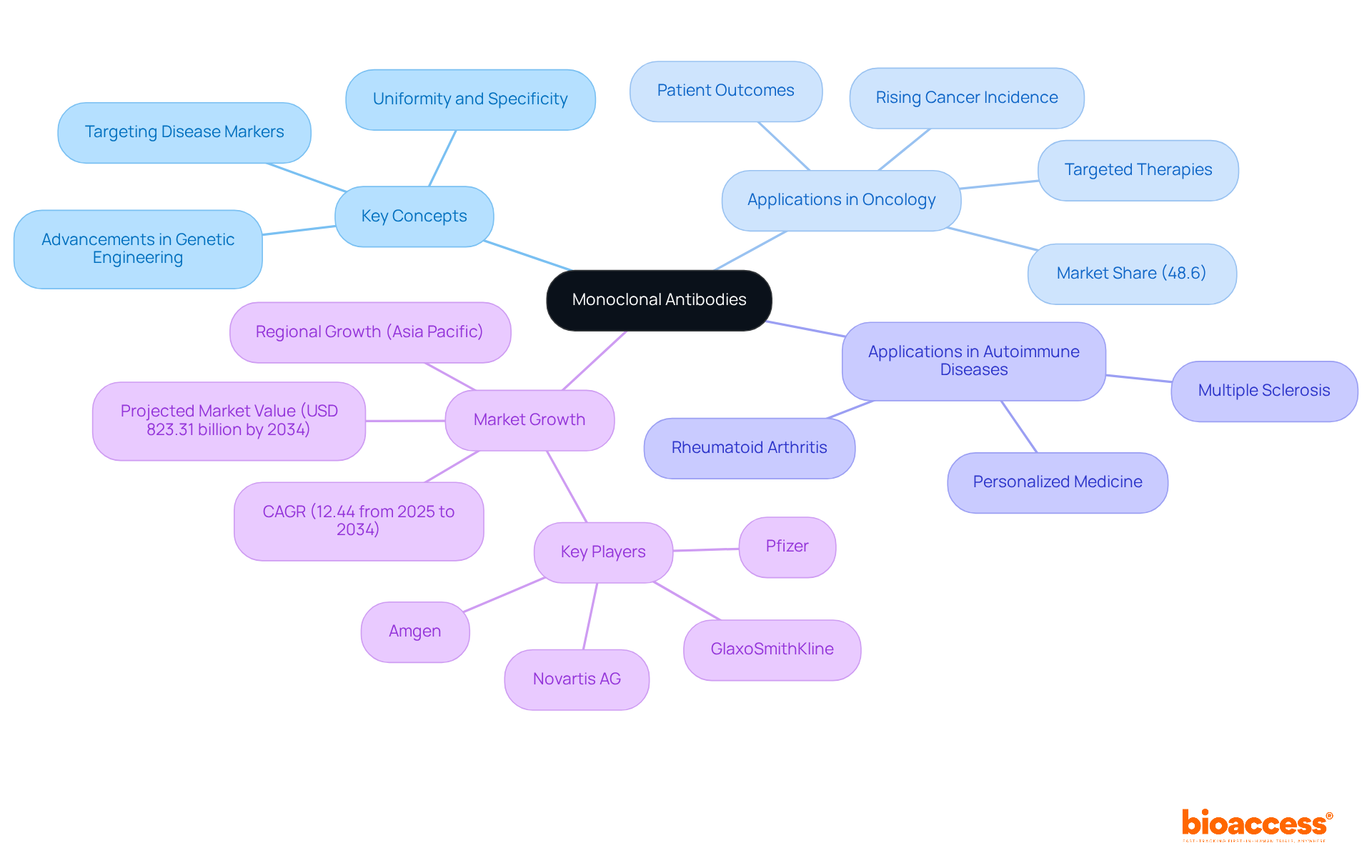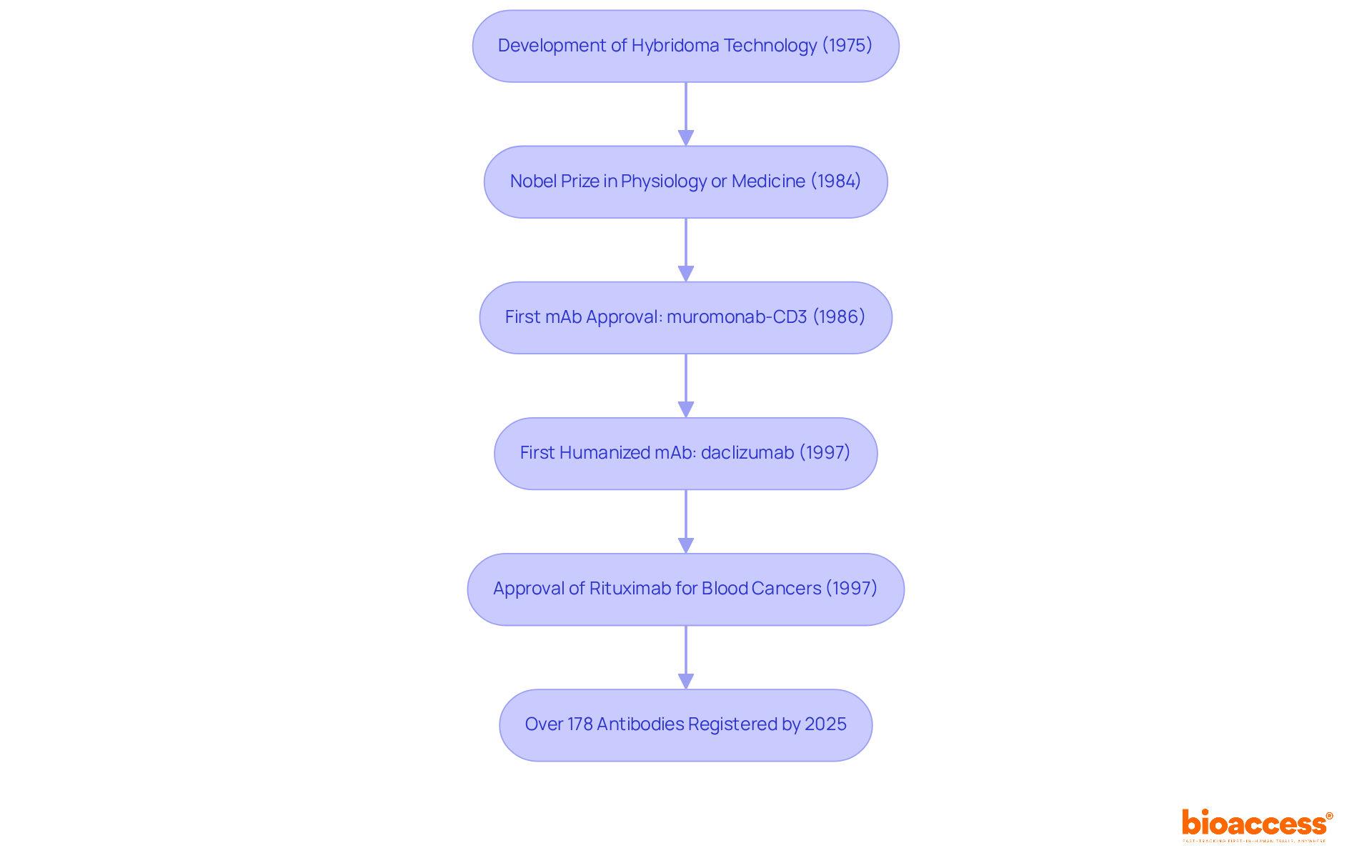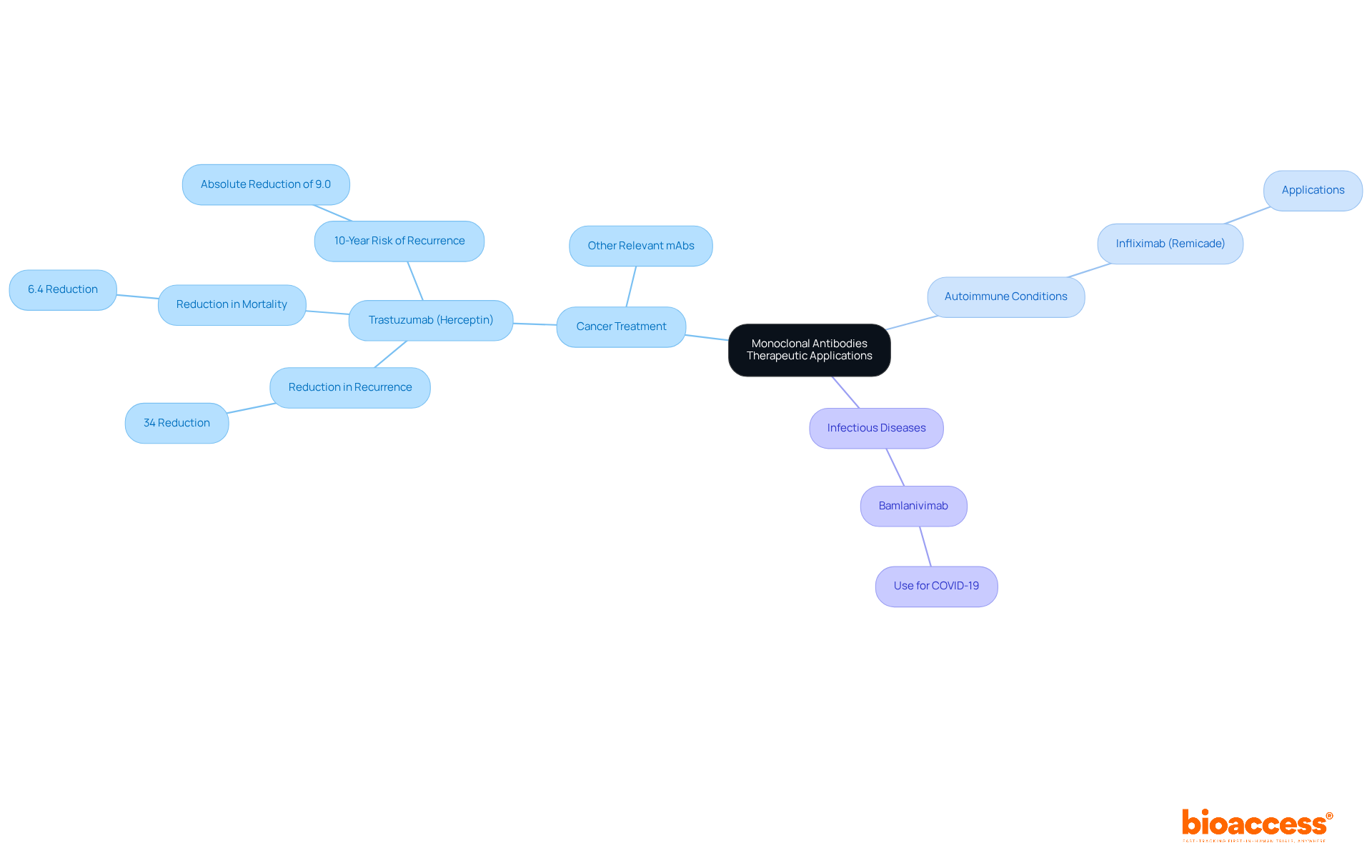


Monoclonal antibodies (mAbs) represent a groundbreaking advancement in medical science, specifically engineered to target distinct antigens on cells. Their role is pivotal in diagnostics and therapeutics, particularly within oncology and autoimmune diseases. This article underscores their significance by exploring recent developments and applications, such as targeted cancer therapies and personalized medicine. These innovations have not only enhanced patient outcomes but are also anticipated to drive substantial market growth in the years ahead.
As we delve deeper into the Medtech landscape, it becomes evident that mAbs are at the forefront of addressing critical challenges in clinical research. Their specificity and effectiveness make them invaluable tools for healthcare professionals striving to improve treatment efficacy. By leveraging these advancements, researchers can navigate the complexities of patient care more effectively, ultimately leading to better health outcomes.
In conclusion, the collaboration between researchers, clinicians, and the Medtech industry is essential for harnessing the full potential of monoclonal antibodies. As we look to the future, it is crucial to continue fostering these partnerships to ensure that innovations translate into real-world benefits for patients.
Monoclonal antibodies (mAbs) stand as a groundbreaking innovation in modern medicine, fundamentally transforming how diseases are diagnosed and treated. These highly specific proteins, derived from a single clone of B cells, facilitate targeted therapies that significantly improve patient outcomes across various medical fields, particularly in oncology and autoimmune disorders.
As the landscape of therapeutic applications continues to evolve, one must consider:
Monoclonal proteins are meticulously designed molecules that attach to specific antigens on cells, effectively mimicking the immune system's natural response to pathogens. Unlike polyclonal antibodies, which originate from various immune cell types, monoclonal antibodies derive from a single clone of B cells, guaranteeing both uniformity and specificity. This distinctive characteristic enables monoclonal antibodies to target specific disease markers, making them essential in diagnostics and therapeutics across multiple medical fields, including oncology, autoimmune diseases, and infectious diseases.
The role of monoclonal antibodies in cancer therapy is particularly noteworthy, as they have transformed treatment protocols by facilitating targeted therapies that improve patient outcomes while minimizing side effects. For example, the oncology segment represented 48.6% of the monoclonal antibody application market in 2022 and is projected to experience the highest growth in the coming years, driven by the rising incidence of cancer and the increasing preference for targeted therapies. Moreover, advancements in genetic engineering are enhancing the therapeutic efficacy and safety of monoclonal antibodies, which are vital for the development of antibody-drug conjugates and biosimilars, further contributing to their growing adoption in clinical settings.
In the realm of autoimmune conditions, monoclonal antibodies have demonstrated significant effectiveness. Real-world applications include therapies targeting rheumatoid arthritis and multiple sclerosis, which have yielded promising results in symptom management and quality of life improvement for patients. The integration of monoclonal antibodies into treatment regimens not only addresses the underlying disease processes but also aligns with the shift towards personalized medicine, where therapies are tailored to individual patient profiles. The increasing prevalence of conditions like rheumatoid arthritis serves as a key driver for the expansion of monoclonal antibody applications in this domain.
Overall, the importance of monoclonal agents in modern healthcare is profound. Their precise targeting of disease markers has revolutionized diagnostics and therapeutics, leading to improved treatment efficacy and safety. As the monoclonal proteins market is anticipated to grow significantly, reaching an estimated USD 823.31 billion by 2034, with a CAGR of 12.44% from 2025 to 2034, their role in advancing healthcare continues to broaden.

The journey of monoclonal immunoglobulins (mAbs) began in 1975 when César Milstein and Georges Köhler developed hybridoma technology, which enabled the creation of identical proteins from a single B cell. This groundbreaking discovery earned them the Nobel Prize in Physiology or Medicine in 1984, marking a pivotal moment in medical research. Initially, monoclonal proteins were primarily used for research purposes, but their therapeutic potential gained recognition in the late 1980s with the approval of the first mAb, muromonab-CD3, aimed at preventing organ transplant rejection.
The approval of daclizumab in 1997 as the first humanized therapeutic agent further underscored the significant milestones in mAb development. Since then, the field has expanded dramatically, with over 178 antibodies registered globally by the start of 2025. This includes more than 162 monoclonal antibodies authorized for various conditions, such as cancer, autoimmune disorders, and infectious diseases. Notably, Rituximab's approval in 1997 for blood cancers exemplifies the transformative role of monoclonal antibodies in targeted therapies.
This remarkable growth highlights significant advancements in contemporary medicine, reflecting a notable rise in the number of treatment antibodies. The launch of expedited review initiatives has notably improved patient access to these essential therapies, emphasizing the importance of collaboration in overcoming challenges in clinical research. As we look to the future, the continued evolution of mAbs raises the question of what does mAb mean for reshaping therapeutic landscapes, making it crucial for stakeholders to engage actively in this dynamic field.

Monoclonal proteins (mAbs) are pivotal in contemporary treatments, particularly in cancer care, where they are engineered to target specific tumor cells and enhance the immune response against malignancies. Take trastuzumab (Herceptin), for instance; it specifically targets the HER2 receptor, which is overexpressed in 15-20% of breast cancers. This targeted approach has led to remarkable improvements in patient survival rates. Studies indicate a 34% reduction in breast cancer recurrence and a 33% decrease in mortality when trastuzumab is combined with chemotherapy. Notably, the absolute 10-year risk of recurrence drops by 9.0%, underscoring the drug's effectiveness in clinical settings. Furthermore, the EBCTCG Secretariat noted that "trastuzumab resulted in comparable proportional decreases in recurrence of ER-positive and ER-negative conditions, as did chemotherapy alone in earlier meta-analyses," reinforcing its broad relevance across various breast cancer subtypes. Additionally, the absolute reduction in breast cancer mortality is 6.4% over 10 years compared to chemotherapy alone, highlighting trastuzumab's significant impact on patient outcomes.
In the realm of autoimmune conditions, monoclonal antibodies like infliximab (Remicade) are employed to inhibit inflammatory pathways, providing substantial relief for conditions such as rheumatoid arthritis and Crohn's disease. These therapies exemplify how monoclonal antibodies can be tailored to target specific disease mechanisms, thereby enhancing treatment effectiveness.
Moreover, monoclonal antibodies have also found applications in managing infectious diseases, such as bamlanivimab for COVID-19, showcasing their adaptability in modern treatment strategies. However, it is crucial to recognize the potential risks associated with trastuzumab, including cardiac toxicity, especially when combined with other treatments. The ability to design monoclonal antibodies for specificity allows for personalized medicine strategies, enabling treatments to be customized to individual patient profiles, thus improving therapeutic outcomes. The global monoclonal antibodies market was valued at USD 210.06 billion in 2022 and is projected to reach USD 494.53 billion by 2030, underscoring the growing importance of these therapeutic agents in the healthcare sector.

Monoclonal proteins (mAbs) play a pivotal role in modern therapeutics, primarily generated through the hybridoma method. This innovative procedure merges B cells with myeloma cells, resulting in hybrid cells that can grow indefinitely. Since its inception, this approach has been crucial in developing highly specific proteins. However, the rise of recombinant DNA technology presents a compelling alternative, allowing for the production of entirely human proteins. This advancement significantly reduces the risk of immune reactions, thereby enhancing patient safety and therapeutic efficacy.
Monoclonal proteins can be classified into several categories based on their origin:
Each type has distinct characteristics that influence their clinical applications. For instance, murine proteins often exhibit higher immunogenicity, while fully human proteins offer better compatibility with the human immune system. A landmark moment in mAb development occurred in 1994 when the FDA approved the first chimeric monoclonal, abciximab.
Despite the growing interest in recombinant techniques, recent advancements underscore the enduring significance of hybridoma technology in generating therapeutic proteins. This method remains a reliable option for producing specific mAbs, especially when rapid production is critical. However, challenges such as maintenance difficulties and the necessity for humanization can complicate its application. In contrast, recombinant DNA technology is increasingly preferred for its ability to produce proteins with enhanced properties, including improved binding affinity and reduced variability. Notably, CHO cells are utilized for 70% of today’s industrially produced protein treatments, underscoring the dominance of recombinant techniques in the field.
For researchers and clinicians, understanding what does mab mean along with the production methods and classifications of monoclonal antibodies is essential. It aids in selecting the most appropriate mAb for specific healthcare needs, ensuring effective treatment outcomes across various medical conditions. As Desmond Schofield aptly noted, "mAbs have proven to be an effective treatment option for many patients suffering from cancer," highlighting their critical role in contemporary therapeutics. Furthermore, the potential for bispecific antibodies represents an exciting frontier in mAb technology, paving the way for innovative treatment approaches.

Monoclonal antibodies (mAbs) stand as a monumental advancement in medical science, offering targeted therapeutic strategies that have reshaped disease treatment. By leveraging the unique properties of these engineered proteins, healthcare providers can deliver more effective and personalized care to patients facing various conditions, including cancer and autoimmune diseases. The precision of mAbs in targeting specific antigens not only boosts treatment efficacy but also reduces adverse effects, marking a significant evolution in therapeutic approaches.
This article has delved into the definition, history, and production of monoclonal antibodies. From their inception in the 1970s to their current applications across diverse medical fields, mAbs have become indispensable in modern healthcare. Their role in oncology has notably expanded with the introduction of targeted therapies, while their effectiveness in managing autoimmune disorders highlights the shift towards personalized medicine. The anticipated growth of the monoclonal antibodies market further underscores their increasing significance in therapeutic development.
Given these advancements, it is essential for stakeholders in the healthcare sector to stay engaged with the evolving landscape of monoclonal antibody research and application. Understanding what mAb means and recognizing its potential can inspire innovative treatment options and enhance patient outcomes. As science continues to advance, the possibilities for monoclonal antibodies in addressing unmet medical needs are vast, reinforcing their crucial role in shaping the future of medicine.
What are monoclonal antibodies?
Monoclonal antibodies are meticulously designed molecules that attach to specific antigens on cells, mimicking the immune system's natural response to pathogens. They are derived from a single clone of B cells, ensuring uniformity and specificity.
How do monoclonal antibodies differ from polyclonal antibodies?
Unlike polyclonal antibodies, which originate from various immune cell types, monoclonal antibodies come from a single clone of B cells, allowing them to target specific disease markers effectively.
In which medical fields are monoclonal antibodies essential?
Monoclonal antibodies are essential in diagnostics and therapeutics across multiple medical fields, including oncology, autoimmune diseases, and infectious diseases.
What is the significance of monoclonal antibodies in cancer therapy?
Monoclonal antibodies have transformed cancer treatment protocols by facilitating targeted therapies that improve patient outcomes while minimizing side effects. They represented 48.6% of the monoclonal antibody application market in 2022.
What factors are driving the growth of monoclonal antibodies in oncology?
The rising incidence of cancer and the increasing preference for targeted therapies are driving the growth of monoclonal antibodies in oncology.
How are advancements in genetic engineering impacting monoclonal antibodies?
Advancements in genetic engineering are enhancing the therapeutic efficacy and safety of monoclonal antibodies, which are vital for developing antibody-drug conjugates and biosimilars.
What role do monoclonal antibodies play in treating autoimmune conditions?
Monoclonal antibodies have shown significant effectiveness in treating autoimmune conditions such as rheumatoid arthritis and multiple sclerosis, improving symptom management and quality of life for patients.
How do monoclonal antibodies align with personalized medicine?
The integration of monoclonal antibodies into treatment regimens addresses underlying disease processes and aligns with the shift towards personalized medicine, where therapies are tailored to individual patient profiles.
What is the projected market growth for monoclonal antibodies?
The monoclonal proteins market is anticipated to grow significantly, reaching an estimated USD 823.31 billion by 2034, with a compound annual growth rate (CAGR) of 12.44% from 2025 to 2034.
What overall impact do monoclonal antibodies have on modern healthcare?
Monoclonal antibodies have revolutionized diagnostics and therapeutics through their precise targeting of disease markers, leading to improved treatment efficacy and safety, and broadening their role in advancing healthcare.